Kevin Saunders
| Kevin Saunders | |
|---|---|
| Born |
Kevin Vaughn Saunders December 8, 1955 Smith Center, Kansas, United States |
| Education | Downs High School |
| Alma mater | Kansas State University |
| Occupation | Motivational Speaker, Paralympian, Author |
| Years active | 1984–present |
| Spouse(s) |
Dora Ortiz (m. 1996) |
| Children | 1 |
| Website |
kevinsaunders |
Kevin Saunders (born December 8, 1955, in Smith Center, Kansas) is an American paralympian, author, and has been recognized one of the top motivational speakers in America. He was the first person with a disability appointed to the President's Council on Fitness, Sports, and Nutrition, and remains the only person to serve two consecutive terms under different administrations, first under George H. W. Bush, and later reappointed by President Bill Clinton.[1]
Early Life and Education
The youngest of three boys, Saunders was born to Donald and Freda Saunders, who owned a farm in north central Kansas. His two siblings were much older, with Gerald, the eldest, graduating from college while Kevin was still an infant.
Saunders enjoyed sports from an early age, and by middle school and high school, he was involved with football, basketball, track and baseball. At graduation, Saunders met U.S. Senator Bob Dole, a fellow Kansan, who spoke at the commencement exercises for Downs High School. Saunders was struck by Sen. Dole’s accomplishments despite a disability he sustained during World War II.
Saunders attended college on athletic scholarships for football, track and field, and soccer. He transferred to Kansas State University, majoring in agricultural economics. While at KSU, he joined the Alpha Tau Omega fraternity and continued to play sports until graduating from the university in 1978.
Explosion and Recovery
After graduating from college, Saunders began training to become a federal inspector for the USDA. As an inspector, Saunders was responsible for checking export grain elevators at major ports. His work assignments included locations throughout the Gulf Coast region, and all along the eastern seaboard, from Florida to Nova Scotia.
Corpus Christi Public Grain Elevator Explosion
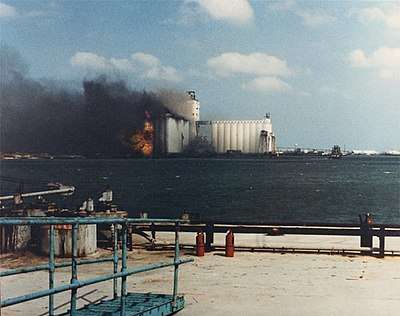
On April 6, 1981, at the age of 23, Saunders identified and reported safety hazards at the Corpus Christi Public Grain Elevator, in Corpus Christi, Texas. He submitted recommendations outlining a temporary shutdown of the facility, and necessary repairs to resolve problems with the failing dust collection system. Management representatives met with the head engineer and declined to act on the inspection report, opting instead to continue normal operations.
The next day, on April 7th, an employee disregarded basic safety precautions during a routine Phostoxin pesticide application, triggering a spark in one of the silos with abnormally heavy grain dust concentrations. The suspended grain dust particles instantly ignited, producing a series of powerful explosions that ripped through the facility at a speed calculated in excess of 1,500 ft per second. The grain elevator’s silos (14-stories tall, 40 ft in diameter with reinforced walls up to 3 ft thick) were destroyed in seconds. There was massive loss of life as many grain elevator employees were either killed by the blast instantly or succumbed to fatal injuries in the moments that followed. Many others suffered severe, life-altering injuries.
Saunders was in the USDA government building when the largest explosion struck. Having heard the sudden blasts erupting just yards away, his last recollection of the event is that “the walls blew out in my face. The crackling and popping of the concrete being blown apart was so loud it felt like it was going to split my head wide open.”
He was instantly knocked unconscious and was blown through the roof of the building. Paramedics found Saunders over 300 ft away, a crumpled mass lying in a pool of blood on a concrete parking lot. Saunders’ injuries were so severe that he was “black-flagged” and not expected to survive. Because all ambulances on the scene were occupied by other survivors, Saunders was placed into a station wagon and driven to Corpus Christi Memorial Hospital. His injuries included a fractured skull, collapsed lungs, shattered scapulas, various internal and external injuries and a severed spine at (T5). His body was broken over at the chest like most people bend at the waist when they bend to touch their toes. Doctors gave him less than 1% chance of survival.
As the explosion garnered national news coverage, doctors worked to first stabilize Saunders’ condition, and then to begin treating some of the injuries. He would spend nearly a year in the hospital and in rehabilitation, before being released in a wheelchair, completely paralyzed from the chest down. Saunders faced a difficult transition to life as a paraplegic, experiencing bouts of depression and emotional distress. He credits former rugby teammates and workout partners (Robert Hays and Bruce Acuna) with forcing him to get back into the gym. In addition to rebuilding his broken body, he was able to overcome feelings of depression and adapt to his new reality.
Athletic career
In 1983 (two years after his injury) Saunders was persuaded by his brother Gerald to try entering his first wheelchair race, the Peachtree Road Race held in Atlanta, Georgia, every year on July 4th. Gerald and his family were now living in Greenville, South Carolina, and they had learned that this was the largest 10K run in the world, offering a wheelchair division in addition to the standard foot race. Saunders signed up on the spot, though he had never trained for a wheelchair race. Nor did he have an understanding of the 10K distance in the early 1980’s, which was before the sport of running had become a mainstream activity. He also lacked the proper equipment, lining up at the start in a standard-issue hospital wheelchair unsuitable for racing. During the race he was unable to maintain pace with other competitors and was eventually disqualified once he was passed by the leading foot runners. Despite the early setback, however, he enjoyed this new sport and made a decision that he would become a better wheelchair athlete. He continued to enter competitions, finding success at the regional, and then national levels.
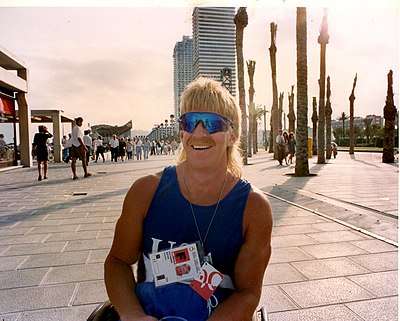
In 1984, Saunders won the bronze medal in the National Wheelchair Athletic Association's Track and Field competition in Johnson City, Tennessee. He would go on to win hundreds of medals in both domestic and international competitions.
Saunders won many gold, silver and bronze medals at the National USA Games, Paralympic Games, Pan American Games, and at various World Track & Field Competitions around the world. He was recognized as the Outstanding Male Athlete at the National and International Games on several occasions.
Saunders has also won many road races throughout the United States and in other countries. He has been a multiple national record holder, Pan American record holder, world record holder and Paralympic Games record holder.
Saunders won every race he competed in at the National Wheelchair Games, including distances from 100m to 5,000m. He also won field events including javelin, discus, swimming, air rifles and pistols, earning Best Athlete of the Games honors on several occasions.
After winning the World Track & Field Championships in England in 1989, Saunders was declared "The World's Greatest All-Around Wheelchair Athlete".[1] At the 1992 Paralympic Games Trials in Salt Lake City, Utah, Saunders broke the pentathlon world record, simultaneously setting a new Paralympic record. Saunders‘ athletic career as an elite wheelchair athlete spanned from 1984 to 2014, when he won the USA Track & Field (USATF) Half Marathon Championship in Houston, Texas.
Throughout his career, Saunders was a member of the National Wheelchair Athletic Association (NWAA), Wheelchair Sports, USA, and Wheelchair & Ambulatory Sports, USA, now known as Adaptive Sports USA. Adaptive Sports USA is a registered multi-sport organization of the United States Olympic Committee/United States Paralympic Committee,dedicated to promoting healthy lifestyles by implementing sports and recreation opportunities for children and adults with a physical disability.
In 2016, Saunders was inducted into the Hall of Fame, recognized for his outstanding achievements as a multiple World & International Champion, multiple Paralympic medalist, multiple Pan American Games medalist and record holder.
President's Council on Fitness, Sports, and Nutrition
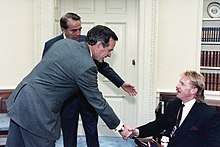 President George H.W. Bush and Sen. Bob Dole thank Kevin Saunders for serving as an ambassador of health and fitness.
President George H.W. Bush and Sen. Bob Dole thank Kevin Saunders for serving as an ambassador of health and fitness.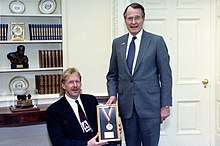 President George H.W. Bush presents Kevin Saunders with a medal to commemorate his contributions to the President's Council on Fitness, Sports, and Nutrition.
President George H.W. Bush presents Kevin Saunders with a medal to commemorate his contributions to the President's Council on Fitness, Sports, and Nutrition.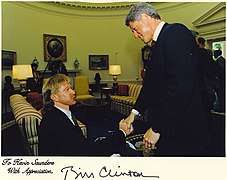 President Bill Clinton thanks Kevin Saunders for his service on the President's Council on Fitness, Sports, and Nutrition. Photo used with permission of the White House.
President Bill Clinton thanks Kevin Saunders for his service on the President's Council on Fitness, Sports, and Nutrition. Photo used with permission of the White House.
In 1991, Saunders became the first person with a disability to be appointed to the President's Council on Fitness, Sports, and Nutrition by President George H. W. Bush. The President selects only 20 individuals nationwide to serve on this Council, making this an exclusive honor and personal achievement.
In 1994, Saunders became the only person to be reappointed to the Council by President Bill Clinton. He served on the Council until 2000. Under President George W. Bush, Kevin was named to a Commission by the President's Council on Physical Fitness and the Department of Health and Human Services to come up with a plan to improve fitness and health for people with disabilities.
He was also commended for his help in the creation of the National Initiative on Physical Fitness for Children and Youth with Disabilities, or the I Can Do It, You Can Do It Program. Saunders also served as an International Ambassador for health, fitness and proper nutrition, a role in which he met with government leaders at the city, state and national level in numerous European countries.
Kansas State Football
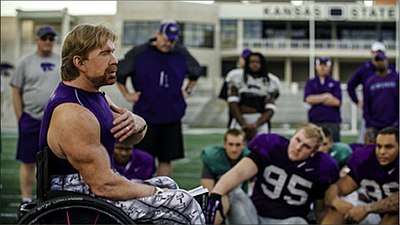
In 1991, driven by the desire to improve his race times, Saunders spent time at his alma mater, KSU. There, he collaborated with the Kansas State University College of Engineering to prototype faster and lighter wheelchair designs. Mutual friends introduced him to the newly hired football Head Coach Bill Snyder, who was impressed by Saunders' story and asked him to serve as the honorary motivational coach to the team.
Saunders remained in that role with the team through 2005, during which time the team went from being one of the worst in the country – ranked last among NCAA Division I-A teams in total offense – to one of the most consistent winners, including a run of 11 straight bowl games. The change in the program was later dubbed “the greatest turnaround in college football history.”
In 1993, Coach Bill Snyder created the "Kevin Saunders Never Give Up Award" for the Kansas State University football team. The award was given to the player who displayed the most courage, determination, dedication, and perseverance in the pursuit of team goals.[2] Many of the award winners have gone on to professional NFL careers, including placekicker Martin Gramática, a member of the 2002 Super Bowl Champion Tampa Bay Buccaneers and 2001-02 Pro Bowl starter.
Kevin Saunders “Never Give Up” Award Recipients
| Year | Name of Recipient | Position |
|---|---|---|
| 2017 | Dalvin Warmack | RB |
| Alex Delton | QB | |
| 2016 | Joe Hubener | QB |
| 2015 | Boston Stiverson | OG |
| Charmeachealle Moore | LB | |
| 2014 | ||
| 2013 | Daniel Sams | QB |
| Tre Walker | LB | |
| 2012 | Nick Puetz | OL |
| 2011 | ||
| 2010 | ||
| 2009 | ||
| 2008 | ||
| 2007 | ||
| 2006 | Marcus Watts | Safety |
| 2005 | Jordan Bedore | OL |
| 2004 | ||
| 2003 | Thomas Hill | TE |
| 2002 | Rock Cartwright | FB |
| 2001 | Travis Wilson | FB |
| 2000 | Jonathan Beasley | QB |
| 1999 | Frank Murphy | RB |
| 1998 | Jeremy Martin | OG |
| 1997 | Travis Ochs | LB |
| Martin Gramática | Placekicker | |
| 1996 | Brian Kavanaugh | QB |
| 1995 | Joe Gordon | CB |
| 1994 | Rod Schiller | FB |
| 1993 | Kitt Rawlings | SS |
Business Career
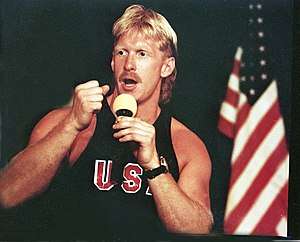
Saunders became a motivational speaker and consultant in 1984, shortly after winning the bronze medal at the USATF Championships in Johnson City, Tennessee. In 1989, Kevin Saunders worked alongside Tom Cruise and Oliver Stone as a principal actor during the filming of the Academy Award-winning film "Born on the Fourth of July" [3]. He has also been featured in over 50 TV commercials promoting safety, fitness, education, sports and wellness.
Saunders is also the author of five books:
- There’s Always a Way (1993)
- CENTAUR (1997) – the first comic book featuring a heart in a wheelchair
- Mission Possible (2003)
- Conversations in Health & Fitness (2004)
- Blueprint for Success (2008)
As a motivational and safety speaker, Saunders speaks to different audiences, including corporate clients, non-profits, and students on topics ranging from motivation and peak performance to workplace safety.
Awards and Recognition
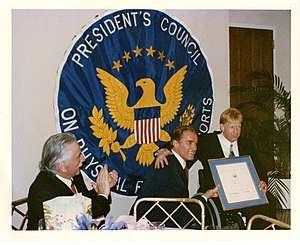
Aside from his athletic accomplishments, Saunders has received more than 100 commendations, proclamations, and awards for his work to improve health and fitness, education and nutrition, including the Torch of Freedom Award given to the year’s Outstanding Sports Figure and the Distinguished Service Award presented by Arnold Schwarzenegger.
In 1993, Saunders was chosen as the outstanding Alumnus and given the award from Pratt Community College, Pratt, Kansas, where he played for the football team on scholarship.
In 1995, Saunders was recognized as Distinguished Alumnus from Kansas State University College of Agriculture.[4] Saunders has also been recognized among Kansas State's 30 most famous alumni.[5]
In 2000, Saunders received a commendation for his outstanding contributions to the President’s Council on Fitness, Sports, and Nutrition from President Clinton Also in 2000, Kevin Saunders was nominated by Del Mar College in Corpus Christi, Texas, and received the Outstanding Alumni Award from the American Association of Community Colleges (AACC) in Washington, D.C. This national distinction was the culmination of nominations from over 1,500 member community colleges across America.[5] Other recipients of the Outstanding Alumni Award include actors Tom Hanks, Robin Williams, Sylvester Stallone, Clint Eastwood, Dustin Hoffman and Tom Arnold, filmmaker George Lucas, fashion designer Calvin Klein, MLB Hall of Famer Nolan Ryan, and professional football coach Dick Vermeil, among other noteworthy individuals.
Philanthropy
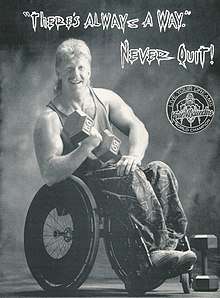
In 1990, Kevin Saunders founded the Wheelchair Success Foundation, a non-profit 501(c)(3) organization dedicated to providing scholarships for college or technical schools to people with disabilities and permanently confined to a wheelchair.
“Every life has value. A disabled person, such as one confined permanently to a wheelchair, is not exempt from earning a college education and contributing to the growth of America. Persons permanently confined to wheelchairs are no less able to be successful college students or citizens,” says Saunders.
In 2004, Saunders founded the Fitness 4 All 50 State Tour, a 501(c)(3) non-profit organization dedicated to educating our nation’s youth, parents, teachers, and administrators about the importance of staying active and making healthy choices for balanced nutritional meals or healthy snacks. Saunders then embarked on the Fitness 4 All 50 States tour to promote lifelong health and fitness. He pushed his wheelchair across the USA, covering over 2,500 miles in his racing wheelchair. Along the way he received over 100 mayoral and state Governors Proclamations declaring "Kevin Saunders Day" for his work in promoting proper nutrition, health and fitness locally and nationally. In each state, he met with Governors and their Health & Human Resource teams, Mayors and their city councils, community business leaders and local students, educating them on the importance of staying physically active and eating healthy foods.
References
- ↑ President Announces Appointment of 14 Members to the President's Council on Physical Fitness and Sports. White House Press Release, May 24, 1994.
- ↑ "K State hands out 2006 football awards". Kansas State Athletics website. 2007-04-21. Archived from the original on 2013-01-27.
- ↑ "Winner? This guy earned that title long ago". Houston Chronicle. 2008-01-14.
- ↑ "Department of Agricultural Economics - Alumni>Distinguished Alumni". Ageconomics.ksu.edu. Retrieved 2012-11-18.
- ↑ Archived April 13, 2009, at the Wayback Machine.
External links
- Kevin Saunders' official website
- : Kevin Saunders' College Scholarship Foundation